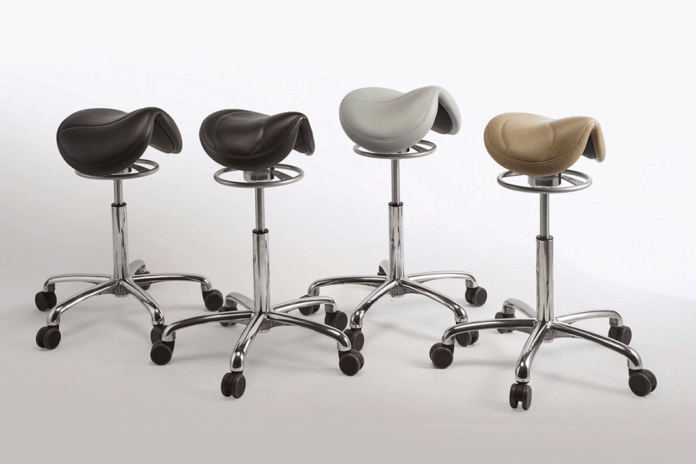Disclosure: We value transparency at Today’s RDH. This review is sponsored content from The Brewer Company as part of our sponsored partner program.
As dental hygienists, we all know the importance of ergonomics. Hygiene program instructors stressed its importance every moment they could. “Shoulders down, elbows in, use your modified pen grasp, and sit up straight” are among a few phrases I heard while in clinic. Ergonomics was stressed for a good reason; to prevent musculoskeletal disorders (MSD) and injury.
Dental hygienists are preventive specialists, yet often some don’t do as much as they can to prevent injury to themselves until an injury has already occurred and the pain sets in. Instead of being proactive, many dental professionals are reactive, when it comes to the importance of ergonomics. There are stunning statistics that back up just how large a problem MSDs are for dental professionals:
- Depending on which population of dentists were studied (Australian, North American (Canada and USA), Greek, Swedish, Danish, and Saudi Arabian), the reported prevalence of MSD pain ranges from 29% to 72%. Numerous studies report that on average 2 out of 3 dentists experienced musculoskeletal pain.1
- Nearly 1/3 of dentists who had to retire early were forced to do so due to disability (MSD)1.
- The reported prevalence of MSD pain and neuropathy in dental hygienists ranges from 60% to 96% depending on the research measures employed and specific population studied2.
- On average, 30% of dental assistants report neck pain1.
Taking preventive measures before you have musculoskeletal disorder or injury is not only essential to your comfort, it’s essential to your overall health, livelihood, and quality of life. As shown by the statistics above, MSDs can lead to premature retirement and shorten a dental professional’s career. MSDs also have a direct effect on a dental practice’s production and revenue. Regardless of if you are a dentist or dental hygienist, think what your daily production is and how much revenue can be lost due to just one day out of the office due to MSDs. Further, consider the numbers if you were out for an extended period of time due to surgery related to MSDs; this can be weeks or even months of lost production and revenue, not to mention loss of take home pay. Doctors, consider how smoothly your day of patient treatment will go if your assistant is out of the office due to MSD pain and/or injury; especially if you have a small practice and employ only one dental assistant. Even if a clinician does not take time off for pain or injury caused by MSDs, constant pain can limit daily production, which lowers total production, on an ongoing basis. Improper ergonomics and MSDs can have an effect on all members of the dental team.
Beyond loss of production, if dental professionals are not actively addressing MSDs, it can lead to sub-standard productivity, disruptions, worker compensation claims, and lost referrals. Severe flare-ups of MSDs can lead to unexpected sick time to be taken, which means the rescheduling of patients and with that, especially when a hygienist isn’t in-office, the potential loss of production from hygiene exams. MSDs can also lead to worker compensation claims that may have been avoided if an actively addressed. Further, extended absences by a member of the dental team might cost an office potential patient referrals due to the lack of consistency in staff members, and the loss of patient rapport and trust that ensues.
There are many ways to help improve ergonomics and lower the risk of MSDs beyond proper patient positioning and proper posture. One of which is an ergonomic operator chair, and more specifically an operator chair that allows for a natural spine position and proper hip placement. The operator chair that can accomplish this is a saddle stool. The Brewer Company’s 135 series saddle stools, in particular, are not only designed to ease the load on back muscles by tilting the pelvis forward to enhance posture and naturally align vertebrae and disks, which also relieves shoulder and neck tension, but it allows for thighs to be slanted downward at a 45-degree angle. This is important because dental professionals tend to lean forward. Leaning forward when the thighs are parallel to the floor, causes the lower back to flatten, causing pressure in spinal discs which can lead to MSDs.
The Brewer Company 135 Series Saddle Stools Review
Specs
I spent some time with the newest saddle stool models, the 135AS and 135JS by The Brewer Company. The stools are available in two seat sizes: the JS model with a wider seat, and the AS model with a narrower seat. The seats are a padded, one-piece design new to Brewer, as opposed to a 2-piece, split-seat design.
The wider seated, 135JS is available in both a standard cylinder height and a high cylinder height. The narrower seated, 135AS is available in both a standard cylinder height and a lower cylinder height. For this review, I tested both the JS model in the dove gray color (item 135JSG) and the AS model in the color of papyrus (item 135ASP), each with a standard cylinder height.
Fit
As a five foot, four-inch woman, with a small to medium build, I found the narrower 135AS stool fit my body size best. The 135JS stool with a wider seat was by no means uncomfortable; I just felt the larger seat size placed my feet and legs just a touch too far apart for my liking. At my shorter height, using the standard cylinder height, I needed to lower the stool as far as it could go to fit the length of my legs. Essentially, a shorter cylinder height would probably fit my height and leg length better.
Comfort
The comfort of the 135AS and 135JS saddle stools are incredible. After four days of prolonged sitting, I did not encounter any sore spots or pressure points. Often, when getting used to a new saddle, some will feel a bit sore as muscles are being engaged that were not engaged before; this is normal, assuming you have a well fitted and adjusted saddle stool in the first place. Personally, I did not experience any soreness with the use of the saddle stools. I should note, not being sore could possibly be due to core-strength and balance ability left over from my ballet and horse riding days of the past. The padding on the seat was also perfectly comfortable for me.
360° Dynamic Motion
A huge reason I believe I did not feel sore or encounter any pressure points is due to the most amazing thing about these saddle stools: the 360° dynamic motion of the seat. 360° dynamic motion is entirely unique to the 135 saddle stools by Brewer. What this means is that the seat moves; not just tilting front to back and/or side to side, but in a full 360° motion. The seat is not firmly and statically attached to the cylinder. In other words, the seat “wiggles” and moves with you. Even better, is that the 360° dynamic motion of the seat is adjustable. I started using the stool adjusted to slight dynamic motion. Each day I increased the motion as I became used to it.
In no way, did the 360° dynamic motion make the stool feel unstable to me. Instead, the dynamic motion made me feel like the stool was working and moving with me, not against me. When I moved and changed positions, the chair moved with me, without causing pressure points.
Dynamic motion is important, especially to dental professionals, because “when you sit in a static operating posture without leaning on your chair’s backrest, more than 50% of your body’s muscles must contract to hold the body motionless while resisting gravity. The static forces resulting from these prolonged, static postures (PSPs) are much more taxing on the body than dynamic (moving) forces. The resultant microtrauma from these PSPs includes muscle imbalances, muscle ischemia, trigger points, and spinal disc degeneration4.” The little bit of instability that comes from the 360° dynamic motion of the Score seat helps with circulation and improves the core muscles, reducing back pain and sitting fatigue. Simply put, 360° dynamic motion in the Score saddle stools is a game changer in ergonomic seating.
Adjustability
Instead of reaching down and trying to find a lever to adjust the seat height and 360° dynamic movement, the 135AS and 135JS models have a ring under the upholstered seat. Pulling up on the ring, no matter which way I was facing, lowers or raises the stool height. The ring easily turns clockwise and counter-clockwise to increase or decrease the amount of dynamic motion of the seat. I found adjusting the seat to be very simple.
Ergonomics
I found these stools to be very helpful in maintaining proper ergonomics and keeping my hips and spine in a natural, ergonomic position. With the natural curve my lower back remained in while sitting on the stool, it took more effort to slump than to sit up properly. With less ability to slump while sitting on the stool, I found that my personal struggle with the improper, head forward position I tend to fall into, was greatly alleviated. I cannot begin to describe the pain caused by the improper head forward position I experience; from headaches to neck and upper back pain, it’s a real problem that I’m sure others can relate to. For me, it was eye-opening to realize that allowing myself to keep the natural curve in my lower back, helped with keeping my head positioned as it should be.
Aesthetics
In my opinion, the Brewer 135AS and 135JS are quality stools; upon sitting they feel sturdy and well-built. They not only feel like a quality piece of equipment but look like it too. The seats’ upholstery on both models I tested, were well-stitched and made of quality material.
The 135AS and 135JS saddle stools are available in Brewer’s three most popular UltraLeather colors: Raven Wing, which is a classic black; Dove Gray, which is a lighter gray; and Papyrus, which is a nice tan. The Dove Gray would look nice in an operatory decorated with cooler colors, whereas, the Papyrus would go nicely in an operatory with natural or warmer colors. Of course, the Raven Wing black will match any operatory.
Some people prefer a narrower option choice, color-wise, for an easy and quick decision, I personally prefer a multitude of options. While I really like the three color options available, it would be fun if the stools were offered in more colors. Again, I feel the color options available will match any operatory; I am just one to like several options.
In closing
As oral health professionals, we are all aware of the importance of ergonomics, as dentistry can be taxing on the body. The question is, are you doing all you can to prevent musculoskeletal disorders or just waiting and hoping “it won’t happen to you?” Beyond the importance of ergonomics as it relates to a clinician’s overall health, the “economics of ergonomics,” and the cost that MSDs can incur (lost production, medical expenses, replacement staff, workers’ comp, etc.), can significantly add up over time.
If you are ready to invest in your overall health and are in the market for ergonomic seating, such as a saddle stool, or if you want to upgrade your current saddle stool, in my opinion, The Brewer Company’s 135AS and 135JS saddle stools are a must try. We are all shaped differently, and some may prefer less or more padding, some like a 2-piece seat; one size certainly doesn’t fit all. However, I feel The Brewer Company hit the nail on the head with these saddle stools, especially with the 360° dynamic motion. As stated earlier, the 360° dynamic motion of the Brewer Score saddle stools are a game changer in ergonomic seating.
For more information and to request a demo of The Brewer Company’s 135AS and 135JS saddle stools, click here.
Download a PDF version of this review
References
- Gupta, A., Ankola, A., Hebbal, M. (2013). Dental Ergonomics to Combat Musculoskeletal Disorders: A Review. International Journal of Occupational Safety and Ergonomics (JOSE) 2013, Vol. 19, No. 4, 561–571. Retrieved from:
https://pdfs.semanticscholar.org/a4f7/98b3a6d1238a8d7d18ef40cb1e1f4cbbdcfc.pdf. - Morse, T., et al. (2007). Musculoskeletal disorders of the neck and shoulder in dental hygienists and dental hygiene students. Journal of Dental Hygiene, Vol. 81, No. 1, January 2007. Retrieved from:
https://pdfs.semanticscholar.org/b7d3/c7412378513ac2aec0f5a8062f5600f31fc9.pdf. - Valachi, B. Move to Improve Your Health: The Research Behind Static Postures. (May, 2011). Dentistry Today. Retrieved from http://www.dentistrytoday.com/ergonomics/5361-move-to-improve-your-health-the-research-behind-static-postures












